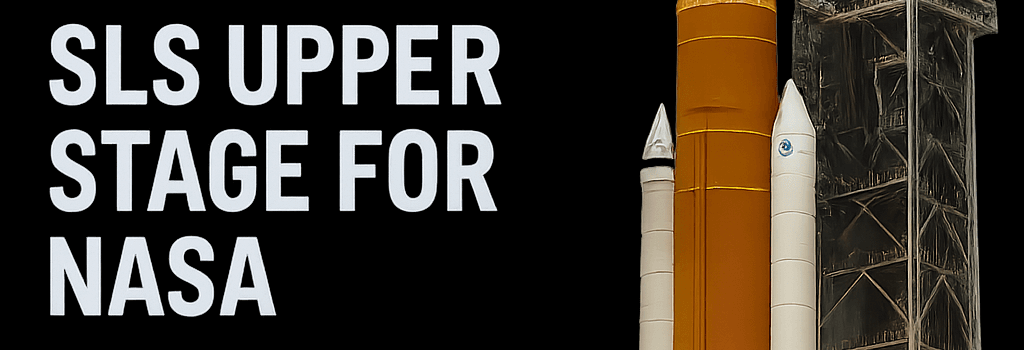Congress Pushes for Cost-Effective SLS Upper Stage for NASA

Updated August 2025 – As NASA moves toward its next Artemis missions, lawmakers in both the House and Senate are pressing the agency to identify a less expensive, faster-to-develop upper stage for the Space Launch System (SLS). The compromise language in the FY2026 appropriations bills preserves the SLS program through Artemis V but directs NASA to conduct a six-month study of alternative architectures and propulsion systems. Below, we explore the technical, budgetary and industrial implications of this high-stakes evaluation.
1. Background: SLS, Artemis and Congressional Oversight
The Space Launch System is NASA’s super-heavy launcher designed to put crews and cargo into lunar orbit. After a successful Artemis I uncrewed test in 2022, Artemis II is slated for early 2026 and Artemis III for a crewed lunar landing at the Moon’s south pole in 2028. The Trump administration originally proposed terminating SLS and the Orion capsule after Artemis III, shifting to commercial solutions for lunar access.
Congress rejected that plan, allocating over $4 billion for SLS IV and V rockets, Orion spacecraft spares, and continued Gateway development. But the House Appropriations Committee’s draft report contains a pointed directive:
“NASA shall evaluate alternatives to the current Exploration Upper Stage (EUS) design for SLS to reduce development and production costs, shorten schedule, and maintain lift capability.”
2. The Exploration Upper Stage (EUS): Specs, Costs and Challenges
2.1 EUS Performance and Architecture
Built by Boeing, the EUS is a cryogenic hydrogen-oxygen stage featuring:
- Four RL10C-3 engines (each delivering ~110 kN thrust vacuum)
- 14 × 5 m diameter propellant tanks for LH2/LOX
- Dry mass ≈ 26 metric tons; propellant mass ≈ 250 metric tons
- Delta-V capacity ~3.8 km/s when paired with the SLS core stage
Compared to the Interim Cryogenic Propulsion Stage (ICPS) flown on Blocks 1–1A, the EUS yields a 40 percent performance boost, enabling co-manifested payloads such as Gateway modules alongside Orion.
2.2 Cost Overruns and Schedule Slippage
According to NASA’s Office of Inspector General, EUS development costs ballooned from $962 million to $2.8 billion, and its initial flight slipped from late 2024 to 2028. The total Block 1B upgrade—core + EUS + launch tower modifications—is now projected at $5.7 billion. Eliminating EUS development today could save NASA an estimated $500 million per year.
3. Legislative Mandates: What’s in the FY2026 Appropriations?
The House draft report directs NASA to:
- Complete a six-month study of alternative upper stages.
- Assess propulsion options (hydrolox, methalox, electric).
- Examine stage configurations and infrastructure compatibility at KSC.
- Explore commercial and international collaboration opportunities.
- Provide cost, schedule and performance trade-studies for each concept.
The Senate bill, while lacking specific EUS language, similarly funds SLS through Artemis V and requires spares procurement until a commercial, human-rated launcher is certified.
4. Technical Alternatives: Pros and Cons
4.1 ULA’s Centaur V
Centrifugal-propulsion stage for United Launch Alliance’s Vulcan rocket:
Specs:
- Single RL10 engine (vacuum thrust ~110 kN)
- 7.5 m diameter LOX tank, 5 m LH2 tank
- Dry mass ~10 t; propellant ~75 t
- Delta-V ~2.5 km/s on SLS core
Pros: Production line active; lower non-recurring costs. Cons: ~35 percent less performance than EUS; fails co-manifested payload requirement without launcher upgrades.
4.2 Blue Origin’s New Glenn Second Stage
Powered by two BE-3U hydrolox engines (~68 kN each), diameter 7 m:
- Dry mass ~9 t; propellant ~82 t
- Delta-V ~2.8 km/s on SLS core
Pros: Reusable potential; existing development roadmap. Cons: 7 m diameter mismatch with SLS electronics & umbilical towers; requires new integration tooling.
4.3 Emerging Methane Oxygen Stages
Several startups (e.g., Relativity, Firefly) are maturing liquid methane/LOX stage concepts with 3–5 engine clusters (100–200 kN thrust each). Benefits include denser propellants, simpler ground infrastructure, and lower boil-off. However, flight-proven systems at scale remain 2–3 years away.
5. Supply Chain, Industrial Base and Workforce Impact
Shuttering EUS or switching to a commercial stage could:
- Affect Boeing’s Glenn Division workforce in Huntsville, AL (∼1,200 jobs).
- Shift manufacturing and test responsibilities to ULA, Blue Origin or new entrants.
- Require Congressional approval for re-allocating funds within NASA’s Exploration account.
Dr. Elena Martinez, aerospace procurement expert at Sierra Space, warns:
“Rapid transitions in hardware vendors risk schedule slips unless NASA maintains clear interface control documents and test-stand continuity.”
6. Cost-Benefit and Performance Trade-Off Analysis
A preliminary NASA study matrix should compare:
- Development NRE vs. per-unit production cost
- Lift capability (kg to TLI) vs. launch cadence requirements
- Infrastructure modification costs at KSC (e.g., tower, umbilicals)
- Long-term supportability and lifecycle operations
Early estimates suggest a Centaur V swap could cut annual costs by 15–20 percent but force two launches for co-manifested missions, increasing mission complexity.
7. Industry and International Collaboration Opportunities
Lawmakers specifically asked NASA to assess commercial and international partnerships. Potential avenues include:
- ESA’s Ariane Group providing hydrolox stages under a barter agreement.
- Japan’s Mitsubishi Heavy Industries contributing cryo-tank manufacturing.
- Commercial firms offering on-demand cryogenic fluid transfer services at KSC.
8. Next Steps and Timeline
NASA is directed to deliver the study by March 2026. The agency must then brief the appropriations committees on findings and recommended go-forward path. A final decision could be embedded in the FY2027 budget request, due February 2026.
9. Conclusion
With hundreds of millions of dollars at stake and Artemis® flight schedules hinging on upper-stage performance, NASA’s evaluation must be rigorous. Balancing cost, performance and industrial base health will be critical to sustaining lunar exploration while paving the way to Mars.
Categories: Tech News, Gadgets & Hardware